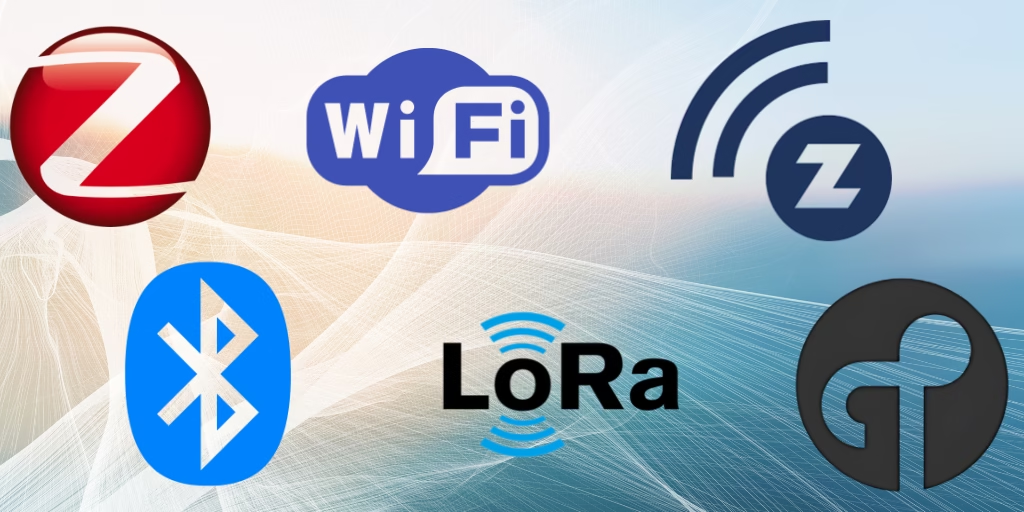Comparing Wireless Technologies for Smart Home Products
As smart home technology continues to evolve, understanding the different wireless protocols (technology) that connect the devices is important.
Smart devices can operate using various wireless protocols, and the specific protocol they use often depends on the device’s design and intended functionality. For instance, a smart light bulb might be compatible with Bluetooth for simple, short-range control through your phone, or Wi-Fi for direct internet connectivity and broader remote access. Alternatively, it could use Zigbee or Z-Wave if it’s part of a larger smart home ecosystem that employs a hub to connect multiple devices seamlessly. LoRa, while less common for indoor devices could be used for outdoor or long-distance devices.
This article will explore the most common wireless protocols—Bluetooth, Zigbee, Wi-Fi, LoRa, Z-Wave and Thread and explain how they work, their pros and cons, and where they fit into your smart home setup.

Bluetooth
Bluetooth is one of the most widely recognised wireless protocols, known for its simplicity and widespread adoption. Initially designed for short-range communication, Bluetooth has been a staple in smart home devices such as door \ window sensors, lights and smart locks.
Advantages:
- Widely supported and compatible with most smartphones, tablets, and computers.
- Low power consumption, making it ideal for battery-powered devices.
- Easy to set up and use directly with any Bluetooth enabled device e.g. phone or tablet. Optionally can connect to a Bluetooth hub to make available to smart home controllers and access over the internet.
Limitations:
- Short range (typically up to 10 metres), limiting its use in larger homes.
- Limited scalability, as it’s not designed to support large networks of devices.

Zigbee
Zigbee is a wireless protocol specifically designed for smart home applications, focusing on energy efficiency and scalability. It operates on a mesh network, allowing devices to relay data through one another to increase coverage.
Advantages:
- Highly energy-efficient, making it ideal for battery-operated devices like sensors and smart locks.
- Supports a large number of devices within a single network.
- Mesh networking ensures reliable communication across larger areas.
Limitations:
- Requires a dedicated Zigbee hub to connect with other smart devices.
- May face interference with Wi-Fi as both often operate on the 2.4 GHz frequency.
Zigbee is an excellent choice for building a comprehensive smart home ecosystem, particularly if you need to connect numerous devices across multiple rooms.

WiFi
Wi-Fi is the backbone of most homes, providing high-speed internet and enabling smart devices to connect directly to the network. Many modern smart home devices, such as cameras, smart plugs, and voice assistants, are Wi-Fi enabled.
Advantages:
- Supports high data transfer rates, ideal for video streaming or complex tasks.
- Eliminates the need for additional hubs, as it connects directly to your router.
- Widely available and familiar to most users.
Limitations:
- Higher power consumption compared to other protocols. Drains the battery quicker than other wireless protocols like Zigbee
- Network congestion can occur if too many devices are connected simultaneously.
- Limited range may require Wi-Fi extenders for large homes.
Wi-Fi is suitable for high-bandwidth devices or applications that require direct internet connectivity, such as smart cameras or streaming devices.

LoRa
LoRa (Long Range) is a lesser-known wireless protocol designed for low-power, long-range communication. It’s commonly used in industrial IoT applications but is gaining traction in domestic smart home technology, particularly for outdoor or remote devices.
Advantages:
- Extensive range, capable of covering up to several miles in open areas. However, more commonly 1/4 mile for domestic outdoor smart devices
- Very low power consumption, suitable for sensors and outdoor devices.
- Works well in areas with limited Wi-Fi or Zigbee coverage.
Limitations:
- Requires a LoRa gateway for operation.
- Limited bandwidth. This has minimal impact on most outdoor smart devices which only require minimal bandwidth
LoRa is ideal for outdoor or remote applications, such as weather sensors, garden monitoring, or smart farming equipment.
A popular brand of LoRa smart home devices is YoLink, who have a massive range of outdoor smart devices. Checkout the Smartout product page for YoLink

Z-Wave
Z-Wave, like Zigbee, is a protocol designed specifically for smart home devices. It also uses mesh networking to provide reliable communication across a range of devices.
Advantages:
- Operates on a unique frequency (908 MHz in the UK) to minimise interference with Wi-Fi networks.
- Reliable and secure, with strong encryption protocols.
- Supports up to 232 devices in a single network, sufficient for most homes.
Limitations:
- Requires a dedicated hub to connect with other devices.
- Less widely adopted than Wi-Fi or Zigbee, limiting device options.
Z-Wave is a solid choice for users prioritising reliability, security, and minimal interference in their smart home setup.

Thread
Thread is a relatively new wireless protocol designed specifically for smart home devices. It focuses on creating a fast, secure, and energy-efficient mesh network, making it highly suitable for smart home ecosystems.
Advantages:
- Mesh Networking: Creates a robust network where devices communicate directly with one another, improving range and reliability.
- Energy Efficiency: Low power consumption makes it ideal for battery-operated devices like sensors and smart thermostats.
- Future Compatibility: Thread is gaining adoption due to its alignment with the Matter standard, ensuring interoperability between devices from different manufacturers.
Limitations:
- Adoption Rates: While growing, Thread is still newer than protocols like Wi-Fi or Zigbee, so fewer devices currently support it.
- Network Setup: Requires a Thread Border Router (like a Nest Hub or Apple HomePod Mini) to connect to other protocols or the internet.
Thread is a forward-looking protocol that enhances connectivity in smart homes. It’s particularly advantageous for users building ecosystems with Matter-supported devices, ensuring seamless interoperability and scalability.
Choosing the Right Wireless Protocol
The best wireless protocol for your smart home depends on your specific needs and preferences. Here’s a quick guide:
- Choose Bluetooth for simple, short-range devices like smart locks or speakers.
- Opt for Zigbee or Z-Wave if you’re building a comprehensive smart home network with multiple devices.
- Use Wi-Fi for high-bandwidth devices like cameras or voice assistants.
- Select LoRa for long-range, low-power applications, particularly outdoors.
Each protocol has its strengths and weaknesses, so understanding your requirements will help you make the right choice.




